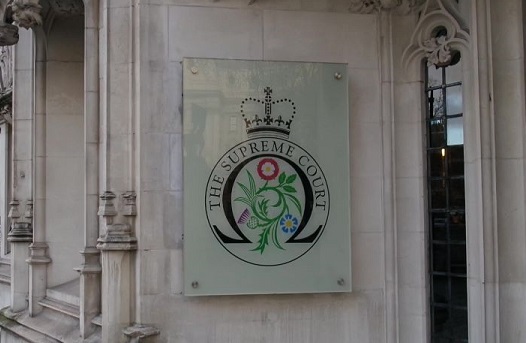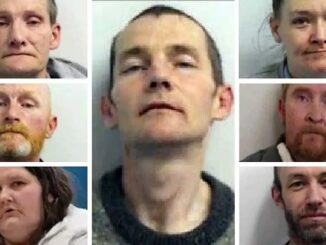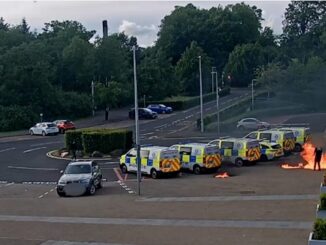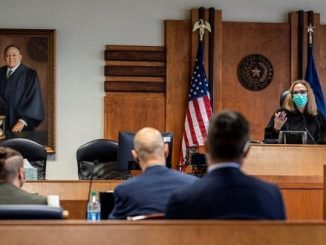
Judges at the Supreme Court are to consider how women are defined in law in a landmark case brought by Scottish campaigners.
It is the culmination of a long-running legal dispute which started with a relatively niche piece of legislation at the Scottish Parliament, but which could have big UK-wide implications.
It will set out exactly how the law is meant to treat trans people, and what it really means to go through the gender recognition process.
And it could have implications for the running of single-sex spaces and services, and how measures aimed at tackling discrimination will operate in future.
What will this case decide?
At the most basic level, it will address what “sex” actually means in law.
Is it about biology and chromosomes set at birth, or does it tie in ideas of gender identity and the gender recognition process?
The Gender Recognition Act of 2004 established the process for obtaining a gender recognition certificate – something it states amounts to a change of sex “for all purposes”.
When someone gets a gender recognition certificate, “if the acquired gender is the male gender, the person’s sex becomes that of a man, and if it is the female gender, the person’s sex becomes that of a woman”.
Then the Equality Act of 2010 came along to set out legal protections against discrimination for specific groups – with “sex”, “sexual orientation” and “gender reassignment” included as protected characteristics.
It simply defines a woman as “a female of any age”.
There has been much dispute about how these two pieces of legislation sit together.
When the Equality Act talks about “sex”, does it mean biological sex – or legal, “certificated” sex as defined by the GRA?
This case won’t change the letter of the law, but a ruling on how it should be interpreted could have big implications for how all kinds of public bodies and services operate, and whether others might be open to legal challenges.
There has been particular controversy in light of the debate about whether the gender recognition process should be streamlined – there was a lengthy wrangle at Holyrood over “self-identification” reforms.
Those were ultimately blocked by the UK government, which claimed they would have a “significant impact” on the Equality Act.
But it plays into a number of other rows, with Scotland’s Rape Crisis network currently in turmoil about how its centres define women and provide single-sex spaces.
Public bodies have expressed frustration about a lack of clarity around interpretation of the law, having been left to work out policy on their own.
Police Scotland – which has faced questions over how it treats transgender people – has criticised an “absence of direction” from politicians in Edinburgh and London over how to reconcile the gender recognition process with the Equality Act.
With political leaders increasingly wary of the topic and the fierce debates which go along with it, it has ultimately fallen to the courts to adjudicate.
How did we get here?
MSPs at Holyrood passed the Gender Representation on Public Boards (Scotland) Act in 2018, with the aim of getting more women onto public sector boards.
That law’s definition of “woman” included people who were “living as a woman” and were currently or proposing to undergo the gender reassignment process.
The campaign group For Women Scotland challenged this in court, and after a series of appeals they eventually prevailed.
Judges ruled that the definition used “conflates and confuses two separate and distinct protected characteristics” laid out in the Equality Act – a reserved piece of legislation which MSPs do not have the power to alter.
The Scottish government had to amend the bill to remove the definition.
But at the same time they issued new guidance alongside the legislation, stating that it would include women as defined by the Equality Act – and also the Gender Recognition Act (GRA), to the effect that a full gender recognition certificate could be taken as a declaration of someone’s sex “for all purposes”.
For Women Scotland challenged this guidance in a fresh judicial review, which ended in defeat.
Judge Lady Haldane ruled in December 2022 that the definition of sex was “not limited to biological or birth sex”, but included those in possession of a gender recognition certificate.
That ruling is what For Women Scotland are challenging at the Supreme Court.
They have already lost one appeal in the Scottish courts, but judges in Edinburgh agreed to push the case straight to the Supreme Court in London for a definitive ruling.
What are the arguments?
The issue being considered by the court is whether “a person with a full gender recognition certificate – which recognises their gender is female – is a ‘woman’ for the purposes of the Equality Act”.
For Women Scotland say the answer to that question is no.
They argue that sex is a “matter of biological fact”, and that “the ordinary, biological meaning of sex is necessary to ensure the rights and protections provided to women”.
They say the Equality Act consistently refers to sex in terms of “immutable biological criteria”, and that it supersedes the GRA thanks to a subsection of the 2004 Act which nods to it being subject to “provision made by … any other enactment”.
The Scottish government meanwhile essentially argues that the two pieces of legislation are clear in their language, and that MPs knew what they were doing when they passed them.
It says there is “no express provision” made in the Equality Act to affect the GRA’s wording that a certificate changes someone’s sex.
Indeed it says there are “clear indications” in the 2010 Act that the GRA “is intended to continue to have full effect” – “namely to reflect, by way of a person having acquired another gender, a change as a matter of law in their sex”.
For Women Scotland will be represented in court by Aidan O’Neill KC, while Ruth Crawford KC will speak for the Scottish government.
Five judges will hear their arguments – headed by the court’s president, Lord Reed – and will retire to consider them before issuing a judgement at a later date.
What could the implications be?
This issue has become so emotive because people on both sides see it as a threat to their very identity.
The most recent census found there were 19,990 people in Scotland who were trans, or had a trans history – under 0.5% of the adult population.
The figure for England and Wales is also around 0.5% – 262,000 people told the last census that their gender identity and birth sex were different.
There is uncertainty around the true figures, with census returns thought to be overestimated – but what we know for sure is that 1,088 full gender recognition certificates were granted across the UK in 2023-24, up from 867 the previous year.
The figure has been rising since application costs were cut – and in the context of this case, it is people with full GRCs who are central.
Beyond this, equalities groups stress that there are a great many minority groups which are protected by the Equality Act, and see this case as potentially being the “thin end of the wedge” which could undermine their rights.
For trans people, they say it could erode the protections against discrimination they have under their reassigned gender.
If someone has a gender recognition certificate attesting that they are a woman, are they entitled to protection from sex discrimination under the Equality Act? Could they make an equal pay claim as a woman?
The UK’s first trans judge – who unsuccessfully applied to intervene in this case – is said to have pursued a pensions claim along those very lines against the Ministry of Justice.
Meanwhile women’s groups also say the ruling will have an impact on a large group – literally half of the population.
They say it could affect the running of single-sex services and spaces. Things like support groups for victims of sexual abuse can only legally justify excluding men due to the Equality Act’s protections.
Campaigners say everything from hospital wards to refuges and sports events might have to change policy or find themselves open to legal challenges based on the court’s ruling.
Lesbian groups – protected under “sexual orientation” in the 2010 Act – also say it could affect their ability to have exclusive clubs.
There could also be political implications.
Some groups see the case as a reason to clarify the actual wording of the law, by having MPs amend the Equality Act itself.
The Equality and Human Rights Commission – the national equalities regulator, which is intervening in the case – has called for this.
They say that MPs did intend to include those with a gender recognition certificate as having changed their sex when they passed the Act in 2010, but that they may not have appreciated consequences which “jeopardise the rights and interests of women and same-sex attracted people”.
They say this is a “wholly unsatisfactory situation, which parliament should address with urgency”.
But some other equalities groups oppose “reopening” the Equality Act, seeing it as a move which could see the rights of protected groups watered down.
And it’s not clear that there is the political will for governments to wade into this topic.
The Scottish government previously tried to take the lead, when Nicola Sturgeon led the charge with self-identification reforms.
But her successors as first minister have backed away from these issues, with current first minister John Swinney pushing plans for a ban on conversion therapy onto the UK government’s desk by calling for a four-nation approach.
At a UK level, rewriting the Equality Act was a Conservative pledge during the election campaign – and not one which Sir Keir Starmer matched.
Indeed Labour’s manifesto promised to “simplify and reform” the gender recognition process, removing “indignities”.
As well as affecting the interpretation of the law as it stands, the ruling in this case could reignite calls for reform in parliament itself.
Source: bbc.co.uk






Be the first to comment